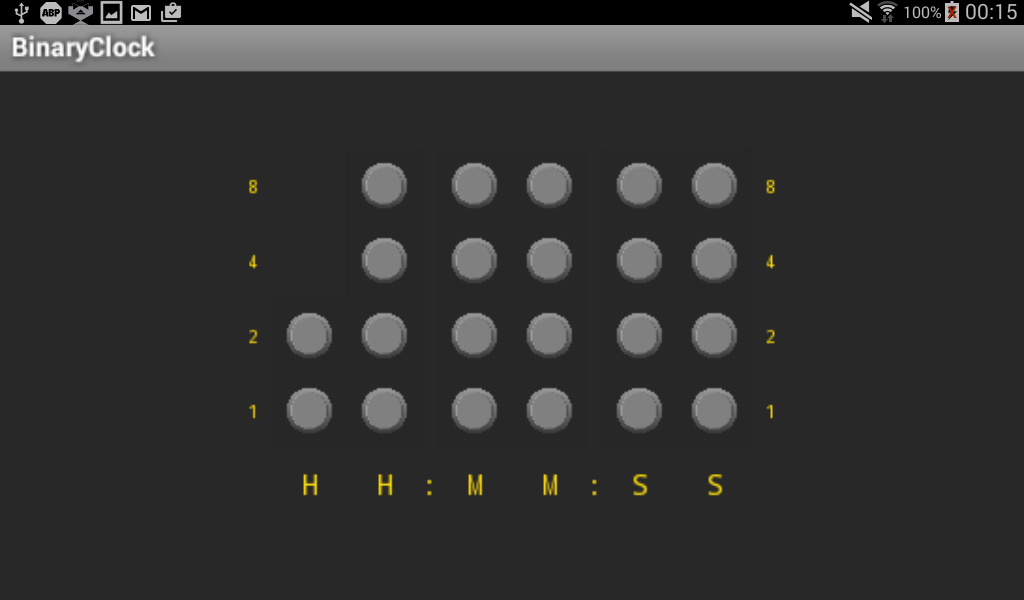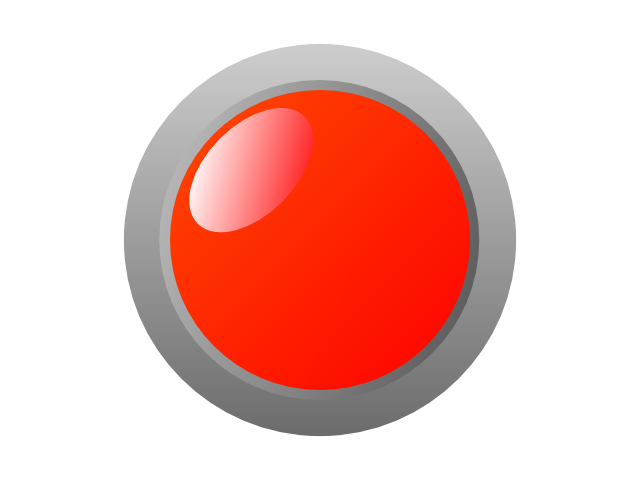Binary Clock Android App In Scala Part 2 Build a binary clock Android application in Scala - Part 2
Introduction
In the first part of this tutorial, we took care of cloning a template project and setting up our environment.
In this part, we will set up a new activity, define a new layout and clean up the project files.
Layout
First, I’m going to create a new layout avoiding the traditional XML and doing it programmatically using only Scala.

In order to do this, we’re going to need two png drawables for the different states of the LEDs.
One for the on state.

Another for the off state.

Next, let’s create a new activity that will replace the default HelloScaloid activity.
I’m going to call this new activity BinaryClock that extends the SActivity and I’ll define a few members.
I keep references to all the image views inside the class scope since they will be updated when the time changes from another method.
I also keep a single reference to the drawables I’ll be using in order to avoid repeating myself.
Then I define layout parameters and gravities for the sake of clarity further down.
The lazy val declarations makes it possible to protect against NPE before the values are initialized during the oncreate callback event, it is only when these variables are de-referenced for the first that an object will be instantiated and their values will be set accordingly.
class BinaryClock extends SActivity{
//Seconds first column LEDs
lazy val s0Led1 : SImageView = new SImageView()
lazy val s0Led2 : SImageView = new SImageView()
lazy val s0Led4 : SImageView = new SImageView()
lazy val s0Led8 : SImageView = new SImageView()
//Seconds second column LEDs
lazy val s1Led1 : SImageView = new SImageView()
lazy val s1Led2 : SImageView = new SImageView()
lazy val s1Led4 : SImageView = new SImageView()
lazy val s1Led8 : SImageView = new SImageView()
//Minutes first column LEDs
lazy val m0Led1 : SImageView = new SImageView()
lazy val m0Led2 : SImageView = new SImageView()
lazy val m0Led4 : SImageView = new SImageView()
lazy val m0Led8 : SImageView = new SImageView()
//Minutes first column LEDs
lazy val m1Led1 : SImageView = new SImageView()
lazy val m1Led2 : SImageView = new SImageView()
lazy val m1Led4 : SImageView = new SImageView()
lazy val m1Led8 : SImageView = new SImageView()
//Hours first column LEDs
lazy val h0Led1 : SImageView = new SImageView()
lazy val h0Led2 : SImageView = new SImageView()
lazy val h0Led4 : SImageView = new SImageView()
lazy val h0Led8 : SImageView = new SImageView()
//Hours first column LEDs
lazy val h1Led1 : SImageView = new SImageView()
lazy val h1Led2 : SImageView = new SImageView()
//Drawables
lazy val ledOffDrawable = getResources.getDrawable(R.drawable.led_off)
lazy val ledOnDrawable = getResources.getDrawable(R.drawable.led_on)
//Layout params definitions
lazy val ledColumnLayoutParams = new LinearLayout.LayoutParams(40 dip, 200.dip)
lazy val legendColumnLayoutParams = new LinearLayout.LayoutParams(20 dip, 200.dip)
lazy val separatorColumnLayoutParams = new LinearLayout.LayoutParams(8 dip, 200 dip)
lazy val squareElementLayoutParams = new LinearLayout.LayoutParams(ViewGroup.LayoutParams.MATCH_PARENT, 40 dip)
//Columns gravity definitions
val ledColumnGravity = Gravity.BOTTOM | Gravity.CENTER_HORIZONTAL
val legendColumnGravity = Gravity.TOP | Gravity.CENTER_HORIZONTAL
val separatorColumnGravity = Gravity.BOTTOM | Gravity.CENTER_HORIZONTAL
val squareElementGravity = Gravity.CENTER | Gravity.CENTER_HORIZONTAL
}
After, I define a few helper methods that will take care of styling the UI elements. Each will accept a specific type of Android UI widget and set the correct attributes.
def styleBinaryPlaceHolder (t: STextView): STextView = {
t height 40.dip typeface Typeface.MONOSPACE textSize 10.dip gravity Gravity.CENTER textColor getResources.getColor(R.color.label)
}
def styleTimePlaceHolder (t: STextView): STextView = {
t height 40.dip typeface Typeface.MONOSPACE textSize 15.dip gravity Gravity.CENTER textColor getResources.getColor(R.color.label)
}
def styleLedDrawable (i: SImageView): SImageView = {
i backgroundColor android.R.color.transparent imageDrawable ledOffDrawable layoutParams squareElementLayoutParams scaleType ImageView.ScaleType.FIT_CENTER
}
Since we reference R.color into the previous methods, it’s important to define colors.xml with the appropriate elements. We only two colors, one the for background and another for the text labels. This also makes it easy to change colors later on.
<?xml version="1.0" encoding="utf-8"?>
<resources>
<color name="background">#f62a2a2a</color>
<color name="label">#ffffdf10</color>
</resources>
Next, let’s implement the onCreate method, it’s analogous to the regular onCreate event from a Java Activity.
In this method, I will assemble the elements of the layout in 8 columns nested into a root layout of type of LinearLayout.
All the columns are also LinearLayouts but Scaloid provides syntactic sugar in order to avoid having to manually specify a vertical LinearLayout.
These columns of LinearLayouts contain various elements, either image views containing the LED drawables or text labels helping the user.
In order to style these elements, I call the helper methods that I previously defined.
onCreate {
//Linear layouts that will make all the different the columns
val binaryLegendLeft = new SVerticalLayout {
style {
case t: STextView => styleBinaryPlaceHolder(t)
}
STextView("8")
STextView("4")
STextView("2")
STextView("1")
} gravity legendColumnGravity layoutParams legendColumnLayoutParams
val binaryLegendRight = new SVerticalLayout {
style {
case t: STextView => styleBinaryPlaceHolder(t)
}
STextView("8")
STextView("4")
STextView("2")
STextView("1")
} gravity legendColumnGravity layoutParams legendColumnLayoutParams
val hours0 = new SVerticalLayout {
style {
case t: STextView => styleTimePlaceHolder(t)
case i: SImageView => styleLedDrawable(i)
}
this += h0Led1
this += h0Led2
this += h0Led4
this += h0Led8
STextView("H")
} gravity ledColumnGravity layoutParams ledColumnLayoutParams
val hours1 = new SVerticalLayout {
style {
case t: STextView => styleTimePlaceHolder(t)
case i: SImageView => styleLedDrawable(i)
}
this += h1Led1
this += h1Led2
STextView("H")
} gravity ledColumnGravity layoutParams ledColumnLayoutParams
val minutes0 = new SVerticalLayout {
style {
case t: STextView => styleTimePlaceHolder(t)
case i: SImageView => styleLedDrawable(i)
}
this += m0Led1
this += m0Led2
this += m0Led4
this += m0Led8
STextView("M")
} gravity ledColumnGravity layoutParams ledColumnLayoutParams
val minutes1 = new SVerticalLayout {
style {
case t: STextView => styleTimePlaceHolder(t)
case i: SImageView => styleLedDrawable(i)
}
this += m1Led1
this += m1Led2
this += m1Led4
this += m1Led8
STextView("M")
} gravity ledColumnGravity layoutParams ledColumnLayoutParams
val seconds0 = new SVerticalLayout {
style {
case t: STextView => styleTimePlaceHolder(t)
case i: SImageView => styleLedDrawable(i)
}
this += s0Led1
this += s0Led2
this += s0Led4
this += s0Led8
STextView("S")
} gravity ledColumnGravity layoutParams ledColumnLayoutParams
val seconds1 = new SVerticalLayout {
style {
case t: STextView => styleTimePlaceHolder(t)
case i: SImageView => styleLedDrawable(i)
}
this += s1Led1
this += s1Led2
this += s1Led4
this += s1Led8
STextView("S")
} gravity ledColumnGravity layoutParams ledColumnLayoutParams
val separatorLeft = new SVerticalLayout {
style {
case t: STextView => styleTimePlaceHolder(t)
}
STextView(":")
} gravity separatorColumnGravity layoutParams separatorColumnLayoutParams
val separatorRight = new SVerticalLayout {
style {
case t: STextView => styleTimePlaceHolder(t)
}
STextView(":")
} gravity separatorColumnGravity layoutParams separatorColumnLayoutParams
//This is where we set the content view
contentView = new SLinearLayout {
this += binaryLegendLeft
this += hours1
this += hours0
this += separatorLeft
this += minutes1
this += minutes0
this += separatorRight
this += seconds1
this += seconds0
this += binaryLegendRight
}.gravity(Gravity.CENTER)
.orientation(LinearLayout.HORIZONTAL)
.backgroundColor(getResources.getColor(R.color.background))
.layoutParams(new LinearLayout.LayoutParams(ViewGroup.LayoutParams.MATCH_PARENT, ViewGroup.LayoutParams.MATCH_PARENT))
}
Result
package com.dontbelievethebyte.binaryclock
import android.graphics.Typeface
import android.view.{ViewGroup, Gravity}
import android.widget.{ImageView, LinearLayout}
import scala.language.postfixOps
import org.scaloid.common._
class BinaryClock extends SActivity{
//Seconds first column LEDs
lazy val s0Led1 : SImageView = new SImageView()
lazy val s0Led2 : SImageView = new SImageView()
lazy val s0Led4 : SImageView = new SImageView()
lazy val s0Led8 : SImageView = new SImageView()
//Seconds second column LEDs
lazy val s1Led1 : SImageView = new SImageView()
lazy val s1Led2 : SImageView = new SImageView()
lazy val s1Led4 : SImageView = new SImageView()
lazy val s1Led8 : SImageView = new SImageView()
//Minutes first column LEDs
lazy val m0Led1 : SImageView = new SImageView()
lazy val m0Led2 : SImageView = new SImageView()
lazy val m0Led4 : SImageView = new SImageView()
lazy val m0Led8 : SImageView = new SImageView()
//Minutes first column LEDs
lazy val m1Led1 : SImageView = new SImageView()
lazy val m1Led2 : SImageView = new SImageView()
lazy val m1Led4 : SImageView = new SImageView()
lazy val m1Led8 : SImageView = new SImageView()
//Hours first column LEDs
lazy val h0Led1 : SImageView = new SImageView()
lazy val h0Led2 : SImageView = new SImageView()
lazy val h0Led4 : SImageView = new SImageView()
lazy val h0Led8 : SImageView = new SImageView()
//Hours first column LEDs
lazy val h1Led1 : SImageView = new SImageView()
lazy val h1Led2 : SImageView = new SImageView()
//Drawables
lazy val ledOffDrawable = getResources.getDrawable(R.drawable.led_off)
lazy val ledOnDrawable = getResources.getDrawable(R.drawable.led_on)
//Layout params definitions
lazy val ledColumnLayoutParams = new LinearLayout.LayoutParams(40 dip, 200.dip)
lazy val legendColumnLayoutParams = new LinearLayout.LayoutParams(20 dip, 200.dip)
lazy val separatorColumnLayoutParams = new LinearLayout.LayoutParams(8 dip, 200 dip)
lazy val squareElementLayoutParams = new LinearLayout.LayoutParams(ViewGroup.LayoutParams.MATCH_PARENT, 40 dip)
//Columns gravity definitions
val ledColumnGravity = Gravity.BOTTOM | Gravity.CENTER_HORIZONTAL
val legendColumnGravity = Gravity.TOP | Gravity.CENTER_HORIZONTAL
val separatorColumnGravity = Gravity.BOTTOM | Gravity.CENTER_HORIZONTAL
val squareElementGravity = Gravity.CENTER | Gravity.CENTER_HORIZONTAL
onCreate {
//Linear layouts that will make all the different the columns
val binaryLegendLeft = new SVerticalLayout {
style {
case t: STextView => styleBinaryPlaceHolder(t)
}
STextView("8")
STextView("4")
STextView("2")
STextView("1")
} gravity legendColumnGravity layoutParams legendColumnLayoutParams
val binaryLegendRight = new SVerticalLayout {
style {
case t: STextView => styleBinaryPlaceHolder(t)
}
STextView("8")
STextView("4")
STextView("2")
STextView("1")
} gravity legendColumnGravity layoutParams legendColumnLayoutParams
val hours0 = new SVerticalLayout {
style {
case t: STextView => styleTimePlaceHolder(t)
case i: SImageView => styleLedDrawable(i)
}
this += h0Led1
this += h0Led2
this += h0Led4
this += h0Led8
STextView("H")
} gravity ledColumnGravity layoutParams ledColumnLayoutParams
val hours1 = new SVerticalLayout {
style {
case t: STextView => styleTimePlaceHolder(t)
case i: SImageView => styleLedDrawable(i)
}
this += h1Led1
this += h1Led2
STextView("H")
} gravity ledColumnGravity layoutParams ledColumnLayoutParams
val minutes0 = new SVerticalLayout {
style {
case t: STextView => styleTimePlaceHolder(t)
case i: SImageView => styleLedDrawable(i)
}
this += m0Led1
this += m0Led2
this += m0Led4
this += m0Led8
STextView("M")
} gravity ledColumnGravity layoutParams ledColumnLayoutParams
val minutes1 = new SVerticalLayout {
style {
case t: STextView => styleTimePlaceHolder(t)
case i: SImageView => styleLedDrawable(i)
}
this += m1Led1
this += m1Led2
this += m1Led4
this += m1Led8
STextView("M")
} gravity ledColumnGravity layoutParams ledColumnLayoutParams
val seconds0 = new SVerticalLayout {
style {
case t: STextView => styleTimePlaceHolder(t)
case i: SImageView => styleLedDrawable(i)
}
this += s0Led1
this += s0Led2
this += s0Led4
this += s0Led8
STextView("S")
} gravity ledColumnGravity layoutParams ledColumnLayoutParams
val seconds1 = new SVerticalLayout {
style {
case t: STextView => styleTimePlaceHolder(t)
case i: SImageView => styleLedDrawable(i)
}
this += s1Led1
this += s1Led2
this += s1Led4
this += s1Led8
STextView("S")
} gravity ledColumnGravity layoutParams ledColumnLayoutParams
val separatorLeft = new SVerticalLayout {
style {
case t: STextView => styleTimePlaceHolder(t)
}
STextView(":")
} gravity separatorColumnGravity layoutParams separatorColumnLayoutParams
val separatorRight = new SVerticalLayout {
style {
case t: STextView => styleTimePlaceHolder(t)
}
STextView(":")
} gravity separatorColumnGravity layoutParams separatorColumnLayoutParams
//This is where we set the content view
contentView = new SLinearLayout {
this += binaryLegendLeft
this += hours1
this += hours0
this += separatorLeft
this += minutes1
this += minutes0
this += separatorRight
this += seconds1
this += seconds0
this += binaryLegendRight
}.gravity(Gravity.CENTER)
.orientation(LinearLayout.HORIZONTAL)
.backgroundColor(getResources.getColor(R.color.background))
.layoutParams(new LinearLayout.LayoutParams(ViewGroup.LayoutParams.MATCH_PARENT, ViewGroup.LayoutParams.MATCH_PARENT))
}
def styleBinaryPlaceHolder (t: STextView): STextView = {
t height 40.dip typeface Typeface.MONOSPACE textSize 10.dip gravity Gravity.CENTER textColor getResources.getColor(R.color.label)
}
def styleTimePlaceHolder (t: STextView): STextView = {
t height 40.dip typeface Typeface.MONOSPACE textSize 15.dip gravity Gravity.CENTER textColor getResources.getColor(R.color.label)
}
def styleLedDrawable (i: SImageView): SImageView = {
i backgroundColor android.R.color.transparent imageDrawable ledOffDrawable layoutParams squareElementLayoutParams scaleType ImageView.ScaleType.FIT_CENTER
}
}
Cleanup
We can now delete the HelloScaloid activity and commit our changes.
We can also change the package name from the manifest.
<?xml version="1.0" encoding="utf-8"?>
<manifest xmlns:android="http://schemas.android.com/apk/res/android"
package="com.dontbelievethebyte.binaryclock"
android:versionCode="1"
android:versionName="1.0">
<application android:label="BinaryClock" >
<activity android:name="BinaryClock"
android:label="BinaryClock">
<intent-filter>
<action android:name="android.intent.action.MAIN" />
<category android:name="android.intent.category.LAUNCHER" />
</intent-filter>
</activity>
</application>
</manifest>
Return 0
That’s it for now.
In part 3, I will implement the logic that updates the SImageView(s) according to the current time and define another method that display a toast reflecting the current time in the traditional human readable form.
blog comments powered by Disqus